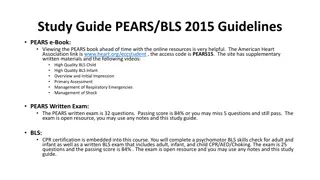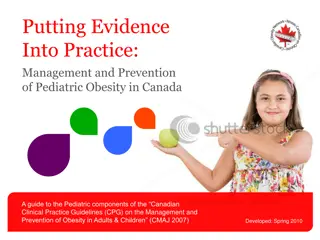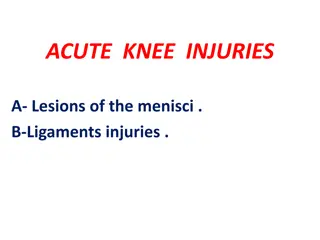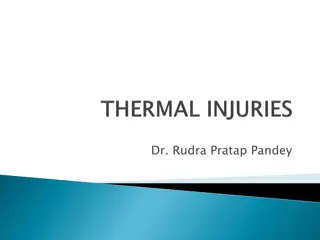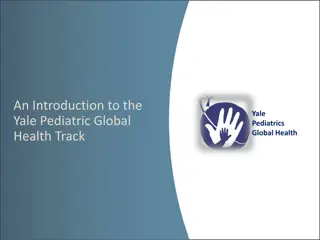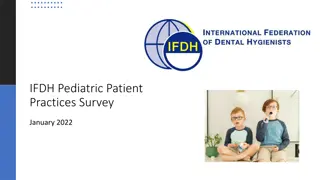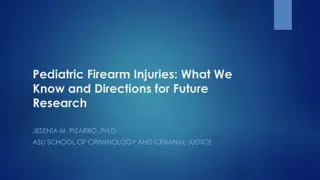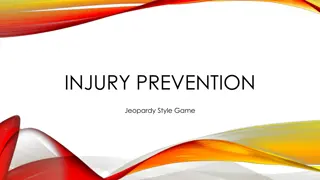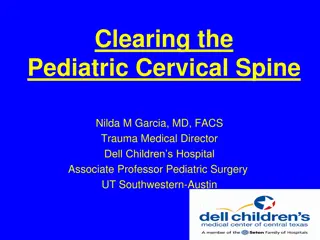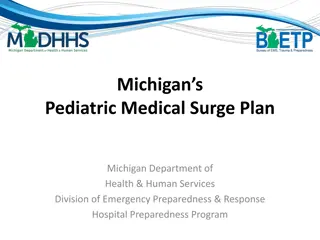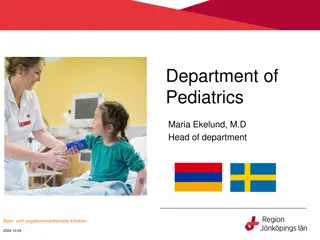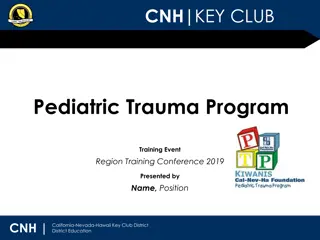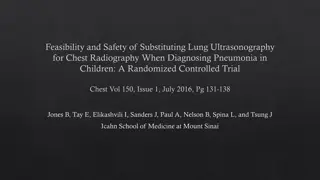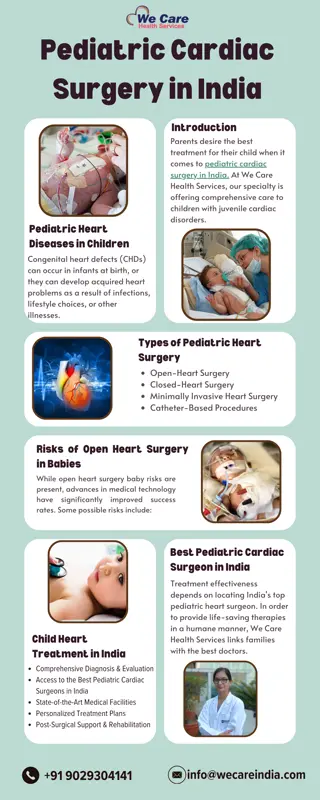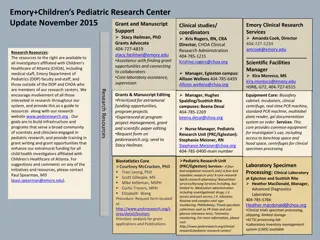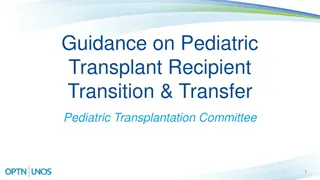Pediatric Workforce Initiative 2025 Presentation Highlights
Explore the key points of the Pediatrics 2025 AMSPDC Workforce Initiative, emphasizing the importance of investing in pediatric health care, the role of pediatric subspecialists, and the need for improved access to specialized care for children and adolescents. The presentation covers reasons to pri
2 views • 28 slides
Comprehensive Guide on Injury, Poisoning, and External Causes
This detailed guide covers various aspects of injuries, poisonings, and other consequences from external causes. It includes information on ICD10 and ICD9 coding, recording and treatment details, vocabulary related to different types of injuries, body parts classification, and code structures for di
2 views • 39 slides
Needlestick Injuries Prevention and Safety
Prevent needlestick injuries by avoiding unnecessary needle use, using devices with safety features, and implementing safe work practices. Healthcare professionals should report injuries promptly, participate in training, and get vaccinated. Be cautious when handling surgical sharps to prevent injur
5 views • 10 slides
Pediatric Trauma Resources: Chest, Abdomen, and Pelvis Review
This guideline provides resources for the evaluation and management of chest, abdomen, and pelvic trauma in pediatric patients. It covers a range of topics including thoracic injuries, abdominal trauma evaluation, nonoperative management protocols, and guidelines for various pediatric injuries. The
5 views • 21 slides
Trusted Partner in Pediatric Wellness is Our QuickMD Care - Google Docs
Quickmdcare-Pediatrician Doctors provides a wide range of Pediatric services in Pediatric hospital at Frisco, Mckinney, Texas. Pediatric Doctors Clinic.
6 views • 1 slides
Enhancing Pediatric Endoscopy Services at Knox County
Knox Endoscopy, dedicated to pediatric endoscopy, faces a growing caseload demanding additional capacity. Existing facilities are at optimal utilization levels, prompting the proposal of a cost-effective Ambulatory Surgical Treatment Center (ASTC). The proposed ASTC is expected to be a more efficien
0 views • 9 slides
Elevator Pitch for Pediatric Champions
Elevator speech helps in defining and communicating the value proposition of a project efficiently. In the context of developing a pediatric champion role, this pitch emphasizes the significance of having a dedicated staff member focused on pediatric readiness, highlighting the need for improved pra
0 views • 5 slides
Pediatric Emergency Assessment and Resuscitation Study Guide
Study Guide for PEARS/BLS 2015 Guidelines covers key topics such as initial assessment, pediatric respiratory emergencies, shock management, and CPR certification. Access online resources and videos for better preparation. Learn about PEARS systematic approach algorithm, hypotensive shock criteria,
0 views • 9 slides
Pediatric Obesity Management and Prevention Guidelines in Canada
This resource provides guidance on pediatric obesity management and prevention in Canada, based on the Canadian Clinical Practice Guidelines. It includes recommendations specific to the pediatric population, implementation strategies, and insights from content experts. The slides cover a range of to
1 views • 66 slides
Acute Knee Injuries: Meniscal Tears and Ligament Injuries
Acute knee injuries, such as meniscal tears and ligament injuries, are commonly caused by trauma or twisting motions. Meniscal tears can lead to pain, swelling, and locking of the knee joint, especially in young active individuals. Understanding the anatomy of the knee joint and meniscus, along with
5 views • 56 slides
Guidelines for Management of Pediatric Venous Thromboembolism
This educational slide set presents the American Society of Hematology's 2018 guidelines for the treatment of pediatric venous thromboembolism. The guidelines cover various aspects such as prevention, treatment, and optimal management of anticoagulation therapy in pediatric patients. Panels were for
1 views • 47 slides
Vehicle Collisions: Causes, Types, and Injuries
Vehicle collisions involve various types such as front impacts, side impacts, and rear-end collisions, resulting in different injuries like back and head injuries, neck injuries, soft tissue damage, broken bones, and internal injuries. Understanding the causes and effects of collisions can help prev
0 views • 14 slides
Ankle Injuries and Pain Overview - MD Pediatric Orthopedics
Explore the causes, types, and treatment of ankle injuries and pain, focusing on sprains, fractures, and impingement issues. Discover insights on ankle sprains in children and adults, ligament anatomy, common injury mechanisms, and essential ligaments involved. Gain valuable information on distingui
0 views • 55 slides
Overview of Burn and Scald Injuries and Classification
Burn injuries from dry heat and scald injuries from hot liquids or steam are common forms of thermal injuries. Other etiological classifications include exposure to chemicals, electrical energy, and radiation. The extent of tissue damage is directly related to temperature and duration. Classificatio
2 views • 31 slides
Pioneering Pediatric Transplantation Initiatives
In the realm of pediatric transplantation, recent projects and upcoming bylaw implementations are focused on enhancing care transition, establishing key personnel requirements, and implementing vital components for kidney, liver, heart, lung, and pancreas transplants. The initiatives aim to improve
0 views • 9 slides
First Aid Tips for Common Trauma Injuries
Learn how to manage various trauma injuries such as skull fractures, eye injuries, blowout fractures, epistaxis, mouth injuries, soft tissue injuries, open injuries, and penetrating wounds with practical first aid techniques. From treating bleeding and impaled objects to saving dislodged teeth and c
0 views • 16 slides
Preventing Road Traffic Injuries: A Global Perspective
Road traffic injuries are a significant global issue, causing millions of deaths and injuries annually. This report highlights the complexity and dangers of road traffic systems, emphasizing the need for increased awareness and preventive measures at governmental, industrial, and individual levels.
1 views • 27 slides
Complications of Fractures: Types and Risks
Complications of fractures can be classified as general, local early, and late complications. General complications include shock, embolisms, and fever while local complications involve injuries to nearby tissues and infections. Early local complications can lead to visceral, vascular, nerve injurie
0 views • 29 slides
Yale Pediatric Global Health Track Overview
The Yale Pediatric Global Health Track aims to equip pediatric residents with the skills and understanding necessary to address child health inequities globally. Residents gain exposure to core health disparity principles, ethical global health principles, and major causes of childhood morbidity. Th
0 views • 13 slides
Mechanical Injuries: Types, Classification, and General Principles
Mechanical injuries encompass a variety of harms caused to the body, mind, reputation, or property. These injuries can be classified into medical, legal, and medico-legal categories based on factors like intentionality. The types of mechanical injuries range from blunt force trauma to thermal, chemi
0 views • 79 slides
Integrative Approaches to Pediatric Pain Management: A Comprehensive Review
Pediatric pain management is a complex issue involving factors such as inflammation, neuroplasticity, and emotional responses. Dr. Matthew Hand explores integrative approaches to address common pediatric pain conditions and highlights the prevalence of chronic pain in children. The presentation delv
0 views • 39 slides
Back Injuries and Prevention Methods
More than 1 million workers suffer from back injuries each year, accounting for a significant portion of workplace injuries. These injuries are not only painful but can also have long-term effects. It is crucial to learn how to avoid injuring or re-injuring your back to prevent pain and avoid potent
1 views • 32 slides
IFDH Pediatric Patient Practices Survey January 2022
Survey conducted by IFDH in January 2022 to understand the practices of dental hygienists with pediatric patients aged 6 to 12. The survey gathered responses from 367 participants across 25 countries, with a focus on demographics, work settings, educational backgrounds, and frequency of seeing pedia
0 views • 19 slides
Pediatric Firearm Injuries and Future Research Directions
Pediatric firearm injuries are a significant public health concern, with thousands of American children affected annually. Research gaps exist in understanding the causes, consequences, and prevention strategies for pediatric firearm injuries. The lack of surveillance data and research funding hinde
0 views • 16 slides
Pediatric Palliative Care and the Role of Interlink Nurses in Northern Ontario
Vicky Wilton, a Pediatric Interlink Nurse in Northern Ontario, presented on pediatric palliative care focusing on identifying differences and similarities between pediatric and adult care, integrating advance care planning, and emphasizing hope. The role of Pediatric Interlink Nurses within the Pedi
0 views • 69 slides
Pediatric Injury Prevention Jeopardy: Leading Causes of Unintentional Injuries
Pediatric injury prevention is crucial in reducing fatalities and non-fatal incidents among children. This Jeopardy-style game highlights the leading causes of unintentional injuries, such as motor vehicle accidents, suffocation, drowning, falls, and more. By educating parents and children and raisi
0 views • 30 slides
Pediatric Cervical Spine Evaluation and Clearance - Comprehensive Review
This informative content delves into the significance, assessment, and clearance of pediatric cervical spine injuries, emphasizing the stratification by age groups and the importance of early evaluation. It highlights the need for spinal clearance in all trauma patients, discusses the immobilization
0 views • 21 slides
Injuries to the Cervical and Thoracolumbar Spine
Cervical spine injuries are common, especially in the 15-30 age group, with motor vehicle accidents, falls, and sports being major causes. Male individuals are more prone to injuries. Neurological deficits are associated with specific types of injuries, necessitating prompt imaging for spinal cord i
0 views • 20 slides
Michigan Pediatric Medical Surge Plan Overview
The Michigan Statewide Pediatric Steering Committee has developed a framework for the Pediatric Medical Surge Plan, with ongoing work needed for review and updates. The plan aims to guide medical care provision for children during disasters, involving various stakeholders and following defined traum
0 views • 18 slides
Birth Injuries in Newborns
Birth injuries in newborns can result from various factors during the birthing process, such as soft tissue injuries and head trauma. Soft tissue injuries like facial abrasions and scleral hemorrhage may occur due to causes like dystocia and forceps delivery. Nursing care involves assessing and reas
1 views • 19 slides
Common Sports Injuries by Dr. Ashish Kumar Dubey
Dr. Ashish Kumar Dubey, Assistant Professor in the Department of Physical Education, categorizes common sports injuries into soft tissue injuries, bone injuries, and joint injuries. Soft tissue injuries include sprains, strains, contusions, abrasions, lacerations, and incisions. Sprains are ligament
0 views • 7 slides
Pediatric Respiratory Infections: An Overview of Cases and Physiology
This review delves into selected cases of respiratory infections in children presented by Dr. David L. Smith, focusing on the anatomical and physiological aspects of the pediatric airway and respiratory system. It discusses respiratory failure in infants and small children, metabolic demands, cyanos
0 views • 49 slides
Dentoalveolar Injuries: Causes and Classification
Dentoalveolar injuries refer to trauma affecting the teeth and their supporting structures. These injuries can range from isolated incidents to significant maxillofacial damage. They are classified into categories based on the affected tissues, including hard dental tissues, pulp, periodontal tissue
2 views • 18 slides
Pediatric Department at Barn-och Ungdomsmedicinska Kliniken - Providing Specialized Care for Children
The Department of Pediatrics at Barn-och Ungdomsmedicinska Kliniken, led by Dr. Maria Ekelund, focuses on providing specialized outpatient and inpatient care for pediatric patients, including newborns. Their mission is to be a knowledge center for children's healthcare, with two wards, a neonatal wa
0 views • 27 slides
Pediatric Trauma Program Training Event 2019 Overview
The Pediatric Trauma Program (PTP) aims to educate and prevent unintentional injuries, the top cause of death among children under 15. This program focuses on common causes such as bike crashes, playground injuries, and drowning. Partnering with hospitals across regions, PTP creates outreach program
0 views • 19 slides
Utility of Lung Ultrasonography in Pediatric Pneumonia Diagnosis
Pneumonia, a leading cause of pediatric mortality globally, presents diagnostic challenges as history and physical exams may not reliably differentiate viral lung infections from bacterial pneumonia. This study explores the feasibility and safety of substituting lung ultrasonography (LUS) for chest
0 views • 21 slides
Pediatric Cardiac Surgery in India
We Care Health Services offers world-class treatment for acquired heart diseases in children and pediatric heart diseases in children through Pediatric Cardiac Surgery in India. The best pediatric cardiac surgeon in India is part of our skilled team,
2 views • 1 slides
Pediatric Cardiac Surgery in India
We Care Health Services' pediatric cardiac surgery in India provides outstanding treatment for kids with heart conditions. Our skilled team, which includes the top pediatric cardiac surgeon in India, specializes in treating pediatric heart conditions
2 views • 4 slides
Pediatric Research Center Resources and Support
The Emory Children's Pediatric Research Center offers a wide range of resources and support for researchers in pediatric healthcare. From grant opportunities to clinical studies coordination, this center aims to enhance extramural funding and provide essential services like grant editing, equipment
0 views • 16 slides
Guidance on Pediatric Transplant Recipient Transition & Transfer
Addressing challenges in pediatric transplant recipient transition and transfer to adult care to improve outcomes and reduce lost-to-follow-up rates. Proposed solutions include guidance for pediatric transplant teams, recommendations for recipients' independence, and maintaining communication betwee
0 views • 11 slides







